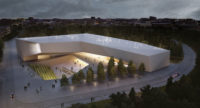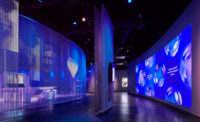Israel’s High Court of Justice has allowed construction to proceed on Jerusalem’s Museum of Tolerance, designed by Frank Gehry and backed by the Los Angeles–based Simon Wiesenthal Center.

Image courtesy Simon Wiesenthal Center
Israel's High Court of Justice has allowed construction to proceed on Jerusalem's Museum of Tolerance, designed by Frank Gehry and backed by the Los Angeles'based Simon Wiesenthal Center.
The court had halted work on the $200 million project in February 2006 in response to petitions by two Muslim groups after graves and human remains were uncovered during the early stages of construction. The closely guarded site in Jerusalem’s center was once part of a large Muslim cemetery but in recent decades served as a parking lot. In Israel, it is not uncommon for human remains to be discovered during construction.
Court-ordered mediation was unsuccessful: The museum backers said they could not change the design or move the museum, an assemblage of freestanding and linked compositions that includes a crescent that will house the main museum, and a two-tiered nautilus-shaped volume that differs substantially from the stone-clad buildings surrounding it. The petitioners rejected the backers' offers to relocate the graves or to "float" the floor above them.
The High Court of Justice concluded in late October that the “national and international importance” and potential benefit of the museum outweighed any violation of the constitutional rights of the deceased. The court allowed construction to proceed on condition that the graves, which were found on 12 percent of the 33.5-acre site, be relocated or a floating floor be built.
The 230,000-square-foot complex is formally called the Center for Human Dignity – Museum of Tolerance Jerusalem. In addition to the semicircular museum, the facility features an education center distinguished by a bouquet of rectilinear limestone-clad volumes, theaters wrapped mostly in glass, a blue-aluminum-and-steel children’s museum, and a conference center whose exterior titanium walls look like deep blue ribbons. The steel-colored nautilus volume will serve as the location of a grand hall and accompanying terrace. Construction was halted during preliminary excavation work; now, the project is expected to be completed by 2014.
At the 2003 groundbreaking and in the court ruling, the museum was seen as promising a “Bilbao effect” that would revive the moribund city center and attract tourism. Rabbi Marvin Hier, the dean and founder of the Wiesenthal Center, says the project has already received $110 million in donations without active fundraising. But human rights groups and others, including the architecture critic of the daily newspaper Ha’aretz, continue to oppose the museum.



